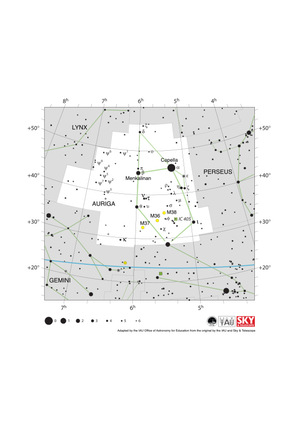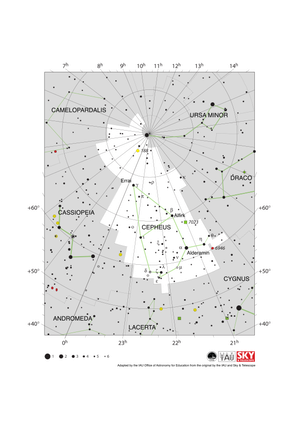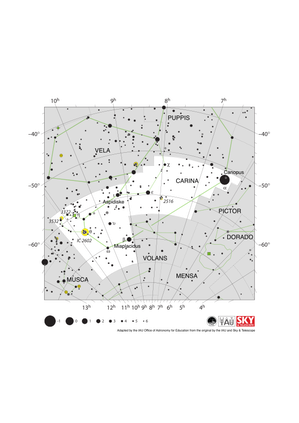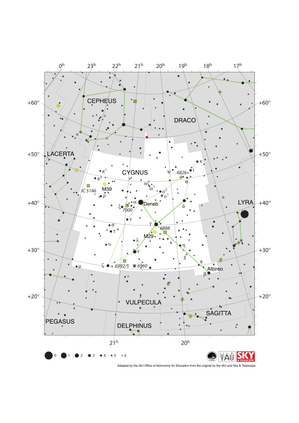Glossary term: 星云
Description: 星云是一种遥远的天体,具有云的外观。通常,星云由星际气体和尘埃组成。在历史上,星云一词指的是所有延展的、边缘模糊的天体,包括我们今天所认识的星系--像银河系这样的遥远恒星系统。如今,星云一词仅限于指代星际介质中的气体和尘埃云,即星系内恒星之间的气体和尘埃。星云被分为许多不同的种类:分子云相对较冷,颜色较暗,主要由分子氢组成;新的恒星就是在这样的云中形成的。巨型分子云可以包含多达数百万个太阳质量的氢气。年轻恒星频繁地喷射出狭窄的电离气体喷流;当这些喷流激发周围的气体时,就会形成一种叫做赫比-哈罗(Herbig–Haro)天体的星云。当大质量恒星形成后,它们的强烈辐射会使周围的气体发出特征性的红光;这种由炽热的电离氢气组成的星云被称为 HII 区(电离氢区)。其他类型的星云与恒星的死亡有关:低质量恒星的死亡会留下不断膨胀的气体外壳,这种星云(命名上有些令人困惑)被称为行星状星云。当大质量恒星以超新星的形式爆发时,喷出的气体会形成一种叫做超新星遗迹的星云。
Related Terms:
See this term in other languages
Term and definition status: The original definition of this term in English have been approved by a research astronomer and a teacher The translation of this term and its definition is still awaiting approval
The OAE Multilingual Glossary is a project of the IAU Office of Astronomy for Education (OAE) in collaboration with the IAU Office of Astronomy Outreach (OAO). The terms and definitions were chosen, written and reviewed by a collective effort from the OAE, the OAE Centers and Nodes, the OAE National Astronomy Education Coordinators (NAECs) and other volunteers. You can find a full list of credits here. All glossary terms and their definitions are released under a Creative Commons CC BY-4.0 license and should be credited to "IAU OAE".
If you notice a factual or translation error in this glossary term or definition then please get in touch.
Related Diagrams
人马座星图
Credit: 国际天文学联合会天文教育办公室(IAU OAE)根据国际天文学联合会和《天空与望远镜》的原文改编
License: CC-BY-4.0 Creative Commons 署名 4.0 国际 (CC BY 4.0) icons
Auriga Constellation Map
Credit: Adapted by the IAU Office of Astronomy for Education from the original by the IAU and Sky & Telescope
License: CC-BY-4.0 Creative Commons 署名 4.0 国际 (CC BY 4.0) icons
Cepheus Constellation Map
Credit: Adapted by the IAU Office of Astronomy for Education from the original by the IAU and Sky & Telescope
License: CC-BY-4.0 Creative Commons 署名 4.0 国际 (CC BY 4.0) icons
Carina Constellation Map
Credit: Adapted by the IAU Office of Astronomy for Education from the original by the IAU and Sky & Telescope
License: CC-BY-4.0 Creative Commons 署名 4.0 国际 (CC BY 4.0) icons
Cygnus Constellation Map
Credit: Adapted by the IAU Office of Astronomy for Education from the original by the IAU and Sky & Telescope
License: CC-BY-4.0 Creative Commons 署名 4.0 国际 (CC BY 4.0) icons
Related Activities
Reading the Rainbow
astroEDU educational activity (links to astroEDU website) Description: By understanding how rainbows work, you can discover about light and its properties, learning about stars, nebulae, galaxies, and our Universe.
License: CC-BY-4.0 Creative Commons 署名 4.0 国际 (CC BY 4.0) icons
Age Ranges:
14-16
, 16-19
, 19+
Education Level:
Informal
, Middle School
, Secondary
, University
Areas of Learning:
Interactive Lecture
, Observation based
, Social Research
Costs:
Low Cost
Duration:
1 hour 30 mins
Group Size:
Group
Skills:
Analysing and interpreting data
, Asking questions
, Engaging in argument from evidence














